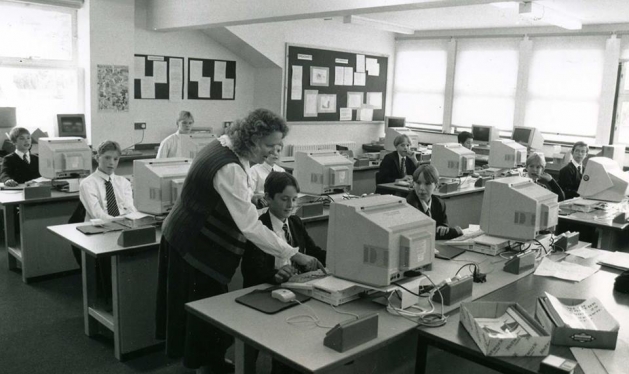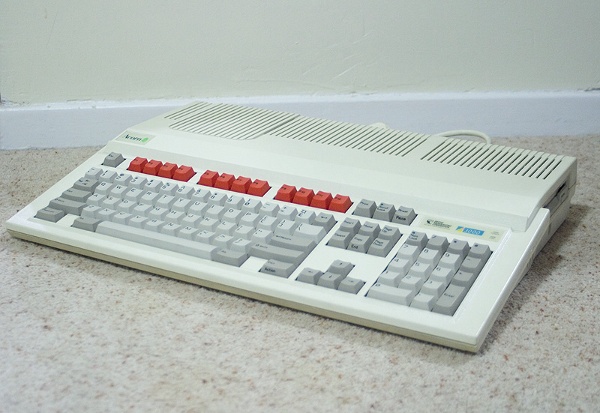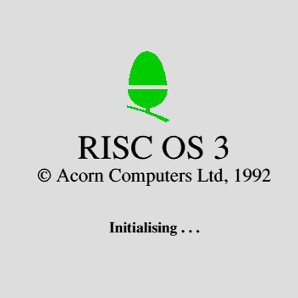Computing in 1995 vs 2017
I was recently tagged in an old school photo from one of our IT lessons which I think was taken around 1995, so it's a good chance to have a look back at how computers have changed in the last 22 years. Extra bonus points if you can spot me!

Our school had decided to use Acorn computers rather than the IBM PCs that went on to become the standard for pretty much all modern home computers. Close-up they looked a little bit like this:

They had this fantastic 3D game available:
But how far have we actually come in the last 22 years of computing? The technical specs have changed massively (average common specs):
| 1995 | 2017 | Increase | |
| Processor | 8 MHz | 4 GHz (x 4 cores) | x 2000 |
| RAM | 1 MB | 8 GB | x 8000 |
| Storage | 1.44 MB (floppy disk) | 500 GB | x 347222 |
| Screen Resolution | 640 x 512 | 3840 x 2160 | x 25 |
| Colours | 256 | 16 M | x 62500 |
| Internet Connection | n/a | 200 Mb/s | x ∞ |
What Has Changed Technically?
Technical specs have changed massively, most performace related specs are thousands of times higher and we now have built-in hard drives as well as the Internet. At school back in 1995, we used to carry 1.44MB diskettes in our inside blazer pockets with our names on. It had all the disk space we needed for the year. Without the Internet, sending files meant physically putting the disk in to another machine or using the local network. Computer games also moved on a lot with modern 3D worlds being almost photorealistic and with an Internet connection that allows you to play with anyone.
What Hasn't Changed?
Although we would have speculated enthusiastically in 1995 about the incredible machines we'd have today, we still use computers in very similar ways for the most part. Our IT lessons included:
- Word Processors
- Spreadsheets
- Desktop Publishing
- Databases
- Mail Merges
- Vector Drawing Packages
- Networking
- Printing
From a user's perspective, most of the above were very similar to what we'd use today.
Although the machines were technically thousands of times slower with hundreds of thousands of times less storage space, they could be used to do exactly the same things - write word documents, use spreadsheets, create and use databases, print documents. The software didn't run slowly either because it was more efficient and smaller.
So how much has the IT industry moved on? Ok everything is higher resolution now, from monitors to the graphics we can store, and we have the Internet and email - which is pretty amazing. But what we actually do with computers and how we use them on a daily basis hasn't changed as much as we imagined it might.
What Has Changed Conceptually?
22 years ago you might have turned on your computer and it might have booted up faster than a mid-range PC would today. You might have used a mouse to select a spreadsheet application and started to update your household budget with the keyboard, you might have selected a word processor and started to write a letter or you might have chosen a desk top publishing application to design a poster. Many of the exact same keyboard shortcuts would have worked then as now.
While many things have stayed the same conceptually, there are a few higher level trends at work:
- Higher Resolution Media
Photos, videos and audio files continue to go to ever higher resolutions, colour depths and frame rates. - More, Smaller, and Cheaper Connected Devices
Back in 1995, very few people had a personal computer at home. If they did, there was probably only one in the household. Today almost everyone has a relatively very powerful, always connected, touchscreen computer in their pocket in the form of a smartphone. They can use it to search not just all of the academic knowledge of humanity at any time but dynamic local information such as opening and closing times of local shops, local weather etc. As well as the smartphone, tablet computers, laptops and netbooks are very common and have all the capabilities of desktop computers. What I expect to see more of is smarter devices in all places. Many TVs already come with built-in computers and many cars have a touchscreen computer built-in to the dash. I can connect to my car with my phone to defrost it on a cold morning and view other information about it. It's likely that as computing power increases and cost and size decrease, almost everything will end up with an embedded computer that can be accessed from a smart phone. It's already the case with smart home devices like light bulbs and some fridges. Soon enough computers should be so small and cheap that they can be added to almost any electrical device perhaps like vacuum cleaners that are linked to Amazon to order new bags when it knows you need them. - More Cloud Computing
Although the paradigm of less powerful terminals connecting to more powerful computers to work hasn't quite happened, there has been a shift in this direction. The Google Chromebook takes this paradigm to the extreme - the computer itself can only connect to the Internet but Google have made web applications that allow you to do most things this way with services that provide storage, word processing, spreadsheets etc. While the Chromebook hasn't been particular popular because it locks you in to one way of working, there is a shift towards some applications working in the cloud. This is the case where really large amounts of processing power are essential such as in voice recognition which has really been perfected. - Voice Interaction
Basic voice recognition was achieved fairly early on in computing, so it was always clear it was possible and would only improve but it wasn't until fairly recently with the emergence of Ok Google and the Amazon Echo that you can ask a computer to do something and it reliably does. At this point in time, there is a limited set of things you can ask and if you venture outside this set, you won't be understood, but it's now flexible enough and good enough to a genuinely useable and reliable method of human computer interaction. - Machine Understanding of Content
Perhaps the most interesting area of improvement in computing is where computers are starting to better understand the information they have reliably stored in enormous quantities. If you have a Google Home device and ask it a question, it can often understand the question and give you the answer based on what it can find on the Internet. The specific question you ask probably won't have been programmed in to the system explicitly and nor will the answer. Instead, very clever computing techniques are able to provide you with a spoken answer in many cases, especially to questions with a clear factual answer.
If you put the above together and extrapolate the trend forward you end up with a future where almost everything is a connected computing device that you can talk to and ask it to do things. You might ask your coffee table to raise up a bit, you might ask your living room lights to add some ambience to the film, you might ask your toaster and coffee machine to make sure you have toast and a hot caffeinated beverage in the morning, you might ask your smartphone to pop out little propellers and fly up to take a selfie of you from the right angle before returning to your hand. As futurist Ray Kurzweil has found, it's hard to predict specifics, but the underlying trends are clear to see and unwavering.
And by the way, I'm at the desk closest the camera on the right as you look at the picture!
What did you think of this article? Are you surprised that computers can't do more? Did you also have curtains in the 90s? Let us know in the comments!
blog comments powered by Disqus


















